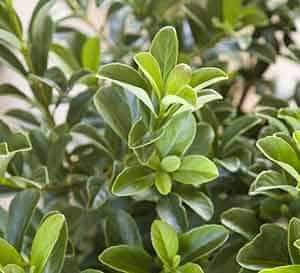With lively purple foliage and a compact, mounding habit, Purple Daydream® Dwarf Loropetalum provides ample opportunity for dynamic plant pairing.
Effective plant companions complement or contrast one another in color, texture or form. Let’s look at a few ideal companions and why they work.
Ground Layer Companion Plants

Depending on the scale of your planting, Purple Daydream itself can serve as a groundcover, but most gardens will include lower-growing companions.
When selecting plants for the ground layer, look for plants that reach a maximum height of 18 inches or less to provide a significant difference in height between plant layers. Try one of these groundcovers:
Endurascape™ White Blush Verbena – The lavender-pink blooms provide a soft echo of color to the purple foliage in sunnier plantings.
‘Buttered Rum’ Heucherella – Purple and orange make a surprisingly warm color scheme combination. Textural differences in the leaves provide gentle contrast.
Evercolor® ‘Everillo’ Carex – Complementary colors on the color wheel, like purple and yellow, always work well together. This combo is perfect for brightening up shadier areas of the garden and provides loads of textural contrast.
Backdrop Companion Plants

Showcase the vibrant foliage of Purple Daydream® against a deep green backdrop; Purple Daydream will create a lovely line of purple in front of privacy plants.
Make sure plant sizes vary enough to establish a multi-layered planting. Consider selecting plants for year-long interest such as spring blooms or winter berries.
Sugar Cookie™ Viburnum – A compact, dense shrub provides evergreen foliage that shifts color with the seasons and produces fragrant spring blooms. A sturdy backdrop that is also dynamic.
White Wedding™ Hydrangea – Though deciduous, the long-lasting white blooms, sturdy branches and large leaves provide plenty of textural contrast throughout the year.
October Magic® Orchid™ Camellia – The lavender fall flowers from this Southern Living October Magic Camellia complement Purple Daydream’s foliage. For variety, try a pink flowering camellia instead.
Spring Sonata™ Indian Hawthorne – Dense, glossy green foliage on this white-flowered shrub provides a constant backdrop while the masses of white spring flowers and purple winter berries provide seasonal highlights.
Add Pizzazz with Accent Plants

A garden composed of rows of similar sized plants would be rather monotonous. We know to place taller plants toward the back of a planting and shorter plants in front, but it is also important to vary plant height along the length of a planting.
This is accomplished by adding accents and specimens as well as so called “filler” plants to the garden. Don’t be afraid to pull taller accents forward in a planting and push low-growing fillers behind a specimen. These variations in height help emphasize focal points.
‘Orange Rocket’ Barberry – The upright habit of the barberry contrasts with the mounded Purple Daydream, providing a strong visual accent. Fast-growing red-orange foliage provides a soothing complement of color.
‘Marvel’ Mahonia – This shade-loving winter bloomer is a focal point full of excitement. Bold texture and yellow winter blooms brighten shade to partial shade gardens and provide contrast to the tidy foliage of Purple Daydream.
‘Lemon Lime’ Nandina – Perfect for intermingling among loropetalums, this vibrant evergreen shrub provides ample contrast in color, texture and form.
Indigo Frost™ Agapanthus – Large globes of white and indigo flowers add a punch of energy to any planting. Flowers echo Purple Daydream’s foliage while long, strappy foliage provides textural contrast.
With all pairings, it is important to consider the cultural needs of each plant. Purple Daydream grows in full sun to part shade and so must its companions. Evaluate the light conditions to determine which full sun plants or part shade plants would perform well in the selected location.
Other considerations include water and soil needs. Keep cultural requirements in mind throughout the plant selection process.
Pin this Dwarf Loropetalum Companion Plant Article!
















